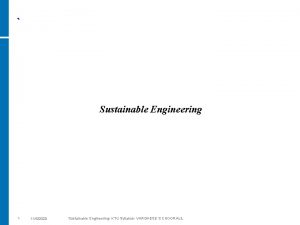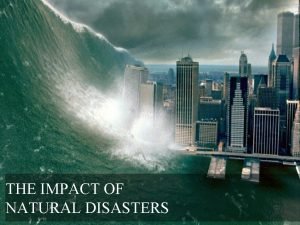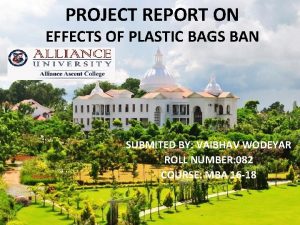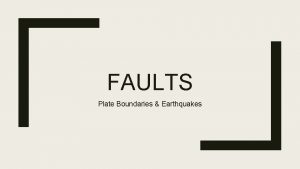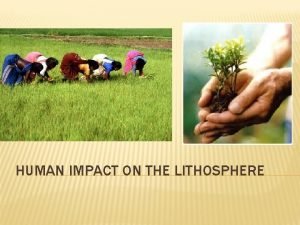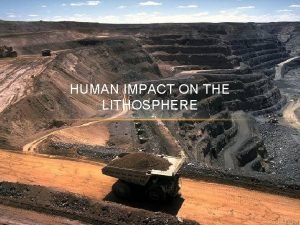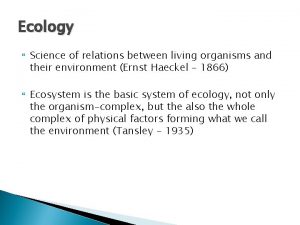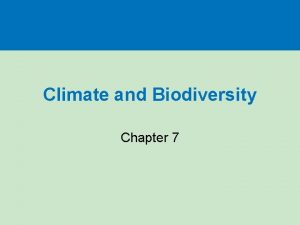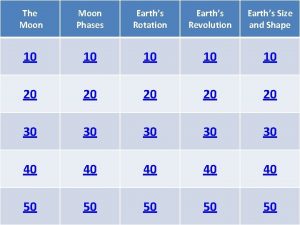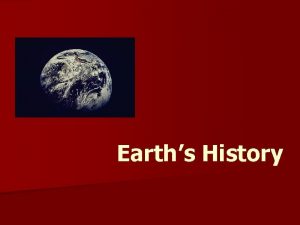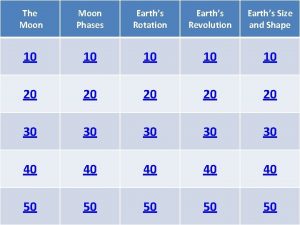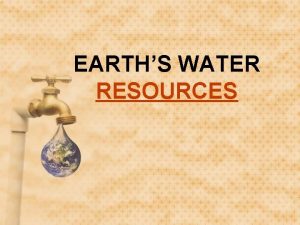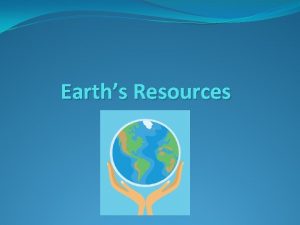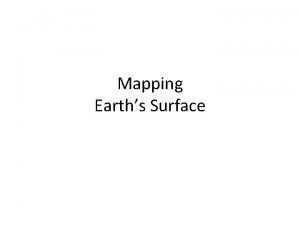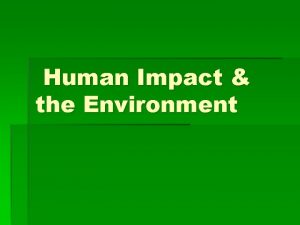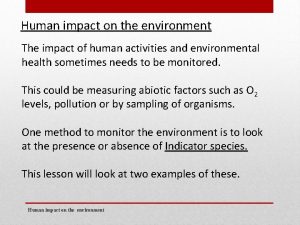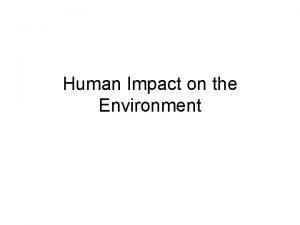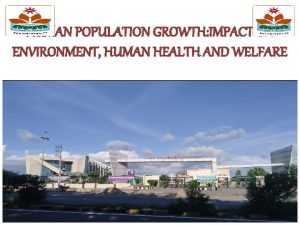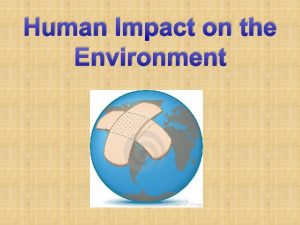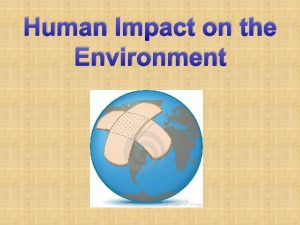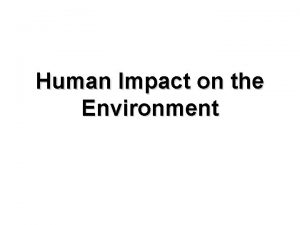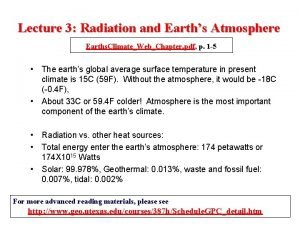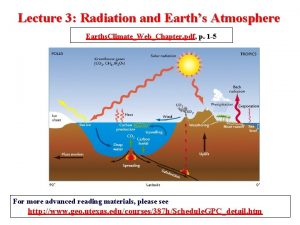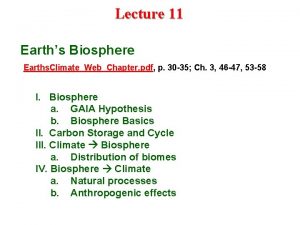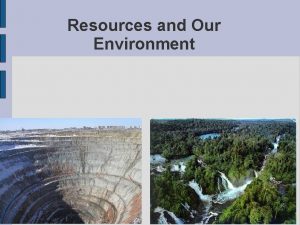Lecture 34 The Human Impact on Earths Environment





































- Slides: 37

Lecture 34 The Human Impact on Earth’s Environment

About Human Impact • Human population is immense, and resources are being consumed at an astounding rate. • Balancing resource usage versus environmental protection is challenging. • It remains to be seen if we can use our resources for sustainable development.

1. Civilization as a Global Geosystem • Civilization exists at the thin interface among the climate, plate tectonic, and geodynamic systems. • Human civilization has profoundly altered the planet, especially in the last 200 years.

1. Civilization as a Global Geosystem: Human Population Growth • 10, 000 years ago – 100 million people • 5, 000 years ago – 200 million people • 700 years ago – 400 million people • By 1800 AD – 1 billion people • By 1974 – 4 billion people • By 2012 – 7 billion people (World’s population doubles now in 47 years. )

1. Civilization as a Global Geosystem: Human Population Growth Scenario A: continued growth as now; B: late 21 st-century level-off; C: decline after 2070

1. Civilization as a Global Geosystem • Humans now alter the global environment on a scale that is staggering compared to natural processes.

1. Civilization as a Global Geosystem ● Example of human changes ● dams and reservoirs now trap 30% of all river sediments ● humans move more soil and rock than all natural processes ● one third of forests cleared ● coolants have damaged the critical ozone layer ● carbon dioxide levels up by ~50%

1. Civilization as a Global Geosystem ● Natural energy resources ● Renewable energy resources ● biomass (wood burning) ● Nonrenewable energy resources ● fossil fuels (oil, gas, coal)

1. Civilization as a Global Geosystem ● Before 1850, most U. S. energy was from wood burning. ● After 1850: the rise of the U. S. fossil-fuel economy.

1. Civilization as a Global Geosystem * * Note – a quad is = to 1015 Btus.

1. Civilization as a Global Geosystem: U. S. Energy Consumption

1. Civilization as a Global Geosystem: Projected Energy Consumption * * Note – OECD includes North America, western Europe, and Australia.

1. Civilization as a Global Geosystem ● Global carbon flux from energy production ● Huge increase from natural rates of carbon transfer ● Carbon economy ● Carbon dioxide is a greenhouse gas

2. Fossil-Fuel Resources ● Fossil-fuel resources and reserves ● Resources – have been discovered ● Reserves – remain in Earth

2. Fossil-Fuel Resources: Remaining Nonrenewable Fossil Fuel

2. Fossil-Fuel Resources ● How oil and gas forms ● Formed in source beds ● May move to reservoirs ● Raw petroleum: crude oil ● Natural gas: methane

2. Fossil-Fuel Resources ● How oil and gas forms ● Crude oil forms under limited conditions called the “oil window. ” ● Crude oil resides in porous rock called an oil reservoir (oil trap). ● Similar conditions apply to gas.

2. Fossil-Fuel Resources: Traps for Oil and Gas





2. Fossil-Fuel Resources ● Distribution of oil resources ● Middle East ● U. S. Gulf Coast and Caribbean ● Other areas

2. Fossil-Fuel Resources: Estimated World Oil Reserves

2. Fossil-Fuel Resources ● Oil production and consumption ● In 2012, 35 billion barrels/yr ● U. S. consumes ~2 times what it produces ● U. S. trade deficit is heavily due to oil importation

2. Fossil-Fuel Resources ● Oil production and consumption ● Hubbert’s peak shows the time of maximum production ● U. S. peak in 1970 ● Departure from trend started in 2008

2. Fossil-Fuel Resources: U. S. Oil Production and Hubbert’s Peak

2. Fossil-Fuel Resources ● Oil and the environment ● oil spills during production ● oil spills during transportation ● contribution of carbon dioxide to the atmosphere

2. Fossil-Fuel Resources Oil spill during production: The Deepwater Horizon disaster (2010)

2. Fossil-Fuel Resources ● Natural gas production ● new technology – “fracking” ● gas from shales is the new frontier for exploration

2. Fossil-Fuel Resources Fracking: Producing gas from shale formations

2. Fossil-Fuel Resources Fracking: How shale gas production is changing the outlook of gas production in the U. S.


2. Fossil-Fuel Resources ● Natural gas and the environment ● Natural gas burns more cleanly than coal. ● Natural gas higher carbon intensity than coal. ● Methane is a greenhouse gas, and burning gas emits CO 2.

2. Fossil-Fuel Resources ● Coal and the environment ● mining pollution problems ● burning and acid rain problem ● contribution of carbon dioxide to the atmosphere

2. Fossil-Fuel Resources: Coal Fields of the U. S.

2. Fossil-Fuel Resources: Typical Coal Strip Mine West Virginia
 01:640:244 lecture notes - lecture 15: plat, idah, farad
01:640:244 lecture notes - lecture 15: plat, idah, farad Sustainable engineering syllabus
Sustainable engineering syllabus Tidal energy environmental impact
Tidal energy environmental impact Effects of environmental disasters
Effects of environmental disasters Plastic ban in your locality project work methodology
Plastic ban in your locality project work methodology Earths layers foldable
Earths layers foldable Earths roation
Earths roation Whats earths moon called
Whats earths moon called What makes one biome different from another?
What makes one biome different from another? Most abundent element in earths crust
Most abundent element in earths crust How thick is the earths crust
How thick is the earths crust Whats earths moon called
Whats earths moon called Whats the thickest layer of the earth
Whats the thickest layer of the earth Earths early atmosphere contained
Earths early atmosphere contained Dinah.com earth's layers foldable
Dinah.com earth's layers foldable Earths major crustal plates
Earths major crustal plates Earths orbit seasons
Earths orbit seasons Brown earth soil profile
Brown earth soil profile Study of earth's physical features
Study of earth's physical features Earth honey
Earth honey What is luna moon
What is luna moon Earths mantle
Earths mantle Earths crust
Earths crust Earths interior
Earths interior Spring earth tilt
Spring earth tilt Atmospheric layers definition
Atmospheric layers definition What is the true shape of earth
What is the true shape of earth Arch of constantine dimensions
Arch of constantine dimensions What does earths tilt do
What does earths tilt do Earths boundaries
Earths boundaries Earths 4 spheres
Earths 4 spheres Financial environment of business
Financial environment of business Human movement impact factor
Human movement impact factor Biome ex
Biome ex Human impact on the lithosphere
Human impact on the lithosphere Human impact on agriculture
Human impact on agriculture Carbon cycle human impact
Carbon cycle human impact Human impact on terrestrial ecosystems
Human impact on terrestrial ecosystems

